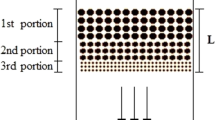Abstract
Expanded Bed experiments were conducted using a mixed mode (MM) resin to capture and purify a recombinant protein produced in yeast fermentation. Expanded bed breakthrough profiles show an overshoot in column effluent concentration of the target protein in the presence of cells and other broth proteins, similar to that seen by other researchers when loading two competing species onto packed beds. In this research, a numerical model assuming negligible axial dispersion is developed and first validated for columns loads that contain only the target protein. This model is solved by finite differences in a unique way that uses an embedded analytical-solution to increase solution speed and stability. To model expanded bed breakthrough of the target protein in the actual cell broth, it was assumed that the other non-product proteins in the broth compete for MM resin binding sites and might be represented as a second “average” species via a traditional two-component competitive Langmuir isotherm. Estimates of the Langmuir constant and broth concentration of this second species were then calculated from batch adsorption data. Using these parameters for the second species, and other batch-derived parameters for the target protein with this resin, this unique numerical modeling approach provided results that compare favorably to experimental breakthrough data at various flow rates. Finally, the model was employed for a parameter sensitivity analysis that shows which process variables are most important in determining breakthrough time and the shape and magnitude of the concentration overshoot.
Similar content being viewed by others
References
Skidmore, G. L., B. J. Horstman, and H. A. Chase (1990) Modeling single-component protein adsorption to the cation exchanger S Sepharose® FF. J. Chromatog. 498: 113–128.
Wright, P. R. and B. J. Glasser (2001) Modeling mass transfer and hydrodynamics in fluidized-bed adsorption of proteins. AIChE J. 47: 474–488.
Tong, X., B. Xue, and Y. Sun (2003) Modeling of expanded-bed protein adsorption by taking into account the particle size distribution. Biochem. Eng. J. 16: 265–272.
Yun, J., D. Lin, and S. Yao (2005) Predictive modeling of protein adsorption along the bed height by taking into account the axial nonuniform liquid dispersion and particle classification in expanded beds. J. Chrom. A 1095: 16–26.
Li, P., A. Xiu, and A. Rodrigues (2005) Experimental and modeling study of protein adsorption in expanded bed. AIChE J. 51: 2965–2977.
Skidmore, G. L. and H. A. Chase (1990) Two-component protein adsorption to the cation exchanger S Sepharose® FF. J. Chrom. 505: 329–347.
Weinbrenner, W. F. and M. R. Etzel (1994) Competetive adsorption of α-lactalbumin and bovine serum albumin to a sulfopropyl ion-exchange membrane. J. Chrom. A. 662: 414–419.
Hashim, M. A., K. H. Chu, and P. S. Tsan (1997) Modeling of protein adsorption in a fixed-bed: Single and two-solute breakthrough behavior. Chem. Eng. Comm. 161: 45–63.
El-Sayed, M. and H. A. Chase (2010) Simulation of the breakthrough curves for the adsorption of α-Lactalbumin and β-Lactoglobulin to SP Sepharose® FF cation-exchanger. Biochem. Eng. J. 49: 221–228.
Chase, H. A. and N. M. Draeger (1992) Expanded-bed adsorption of proteins using ion exchangers. Sep. Sci. Technol. 27: 2021–2039.
Feuser, J., J. Walter, M. -R. Kula, and J. Thommes (1999) Celladsorbent interactions in expanded bed adsorption of proteins. Biosep. 8: 99–109.
Mercier-Bonin, M., H. Vergnault, and R. Willemot (2004) Physicochemical parameters involved in the interaction of Saccharomyces cerevisiae cells with ion-exchange adsorbents in expanded bed chromatography. Biotechnol. Prog. 20:1534–1542.
Fernandez-Lahore, H. M., A. Nagel, M. -R. Kula, and J. Thommes (2000) The influence of cell adsorbent interactions on protein adsorption in expanded beds. J. Chrom. A. 873: 195–208.
Chen, W., X. Dong, and Y. Sun (2003) Modeling of the whole expanded-bed protein adsorption process with yeast cell suspensions as feedstock. J. Chrom. A. 1012: 1–10.
Wang, X., A. Hunter, and N. Mozier (2009) Host cell proteins in biologics development: Identification, quantification and risk assessement. Biotechnol. Bioeng. 103: 446–458.
Lihme, A. (1997) Mixed mode resins for isolation of proteins. Europe Patent EP1 386 660 A1.
Noel, R., B. Hansen, and A. Lihme (2007) Industrial processing of immunoglobulins. Bioprocess Internatl. 5 (5): 58–61.
Kelly, W., P. Garcia, S. McDermott, P. Mullen, G. Kamguia, G. Jones, A. Ubiera, and K. Göklen (2012) Experimental characterization of next generation expanded bed adsorbents. Biotechnology and Applied Biochemistry. Awaiting review.
Hall, K. (1966) Pore- and solid-diffusion kinetics in fixed-bed adsorption under constant-pattern conditions. Ind. Eng. Chem. Fund. 5: 212–223.
Weber, T. and R. Chakravorti (1974) Pore and solid diffusion models for fixed-bed adsorbers. AIChE J. 20: 229–237.
Cooper, R. (1965) Slow particle diffusion in ion exchange columns. Ind. Eng. Chem. Fund. 4: 308–313.
Fan, L. S., Y. C. Yang, and C. Y. Wen (1960) Mass transfer in semifluidized beds for solid-liquid systems. AIChE J. 6: 482–487.
Meechai, N., A. M. Jamieson, and J. Blackwell (1999) Translational diffusion coefficients of bovine serum albumin in aqueous solution at high ionic strength. J. Colloid and Interface Sci. 218: 167–175.
Author information
Authors and Affiliations
Corresponding author
Rights and permissions
About this article
Cite this article
Kelly, W., Kamguia, G., Mullen, P. et al. Using a two species competitive binding model to predict expanded bed breakthrough of a recombinant protein expressed in a high cell density fermentation. Biotechnol Bioproc E 18, 546–559 (2013). https://doi.org/10.1007/s12257-012-0754-2
Received:
Revised:
Accepted:
Published:
Issue Date:
DOI: https://doi.org/10.1007/s12257-012-0754-2




